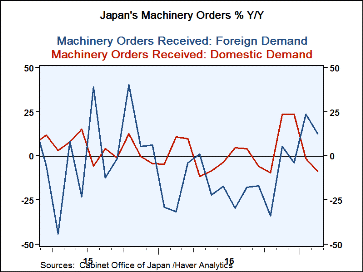 Global| Apr 12 2017
Global| Apr 12 2017Japan's Core Machinery Orders Advance in February
Summary
Japan's core machinery orders strip out the large lumpy projects that can dominate the series. The core orders are what's left. That series is up by 1.5% in February, reversing a 3.2% drop in January after a 2.1% increase in December. [...]
 Japan's core machinery orders strip out the large lumpy projects that can dominate the series. The core orders are what's left. That series is up by 1.5% in February, reversing a 3.2% drop in January after a 2.1% increase in December. Even with the lumpy projects off the books, the core series is still pretty bumpy. But the year-on-year percentage changes in the total series are still some 40% more volatile than the core readings. On a month-to-month basis, the total readings are 70% more volatile.
Japan's core machinery orders strip out the large lumpy projects that can dominate the series. The core orders are what's left. That series is up by 1.5% in February, reversing a 3.2% drop in January after a 2.1% increase in December. Even with the lumpy projects off the books, the core series is still pretty bumpy. But the year-on-year percentage changes in the total series are still some 40% more volatile than the core readings. On a month-to-month basis, the total readings are 70% more volatile.
Orders Have Low Signal-to-Noise Ratio
All this means that it is hard to extract a true signal from the orders data. Still, the chart shows that orders activity has picked up recently especially for core orders. The sequential core order growth rates are positive on all horizons of 12-month, six-month and three-months. Total orders on foreign and domestic demand each show weakness and order declines over the recent three-month period.
Japan's PMI Data Are Positive
Elsewhere Japan's PMI data show that the manufacturing PMI has steadied in the range of 52 in recent months and its March reading stands in the top 25th percentile queue of values over the past five years. The Markit services PMI adds a supporting lift with better momentum and has an even stronger, top 11th percentile standing over the past five years.
Most Signs Point Higher for Japan's Growth
Japan has a variety of surveys for manufacturing, 'industry,' services and other sector details. For the most part, the message of these various surveys is that the economy is moving ahead although the speed indicated is not particularly strong.
The Deflation Fight
Japan continues to fight the battle to dislodge deflation forces. In March Japan's PPI rose by 0.2%, a slightly lesser gain than February's (upwardly revised) 0.3% rise; both of which were reported today. Year-on-year, Japan's PPI is up by 1.4%. Recent Japanese demographic data have shown that its pace of population drop has slowed according to a report released on Monday. Still, by the year 2065, Japan's population is estimated to drop by nearly one-third. A lesser decline could be very helpful is arresting the forces of deflation.
Kuroda Addresses Topical Issues
On balance, Japan's data are positive but hardly robust. Deflation is being held at bay, but that is being helped by rising global oil prices. Japan continues to struggle to get growth on firmer ground and to rid itself of deflation for good. Speaking this morning in Tokyo, BOJ Governor Haruhiko Kuroda denied that Japan's policies were being aimed at the foreign exchange market. Mr. Kuroda, speaking at the lower house fiscal and monetary affairs committee, said the BOJ was using quantitative easing to meet its 2% inflation target. He said that the BOJ's outlook for prices was not based on forecasts for future currency moves. However, he also said that if the yen weakened, it was possible that prices would rise towards the 2% inflation target more quickly.

Robert Brusca
AuthorMore in Author Profile »Robert A. Brusca is Chief Economist of Fact and Opinion Economics, a consulting firm he founded in Manhattan. He has been an economist on Wall Street for over 25 years. He has visited central banking and large institutional clients in over 30 countries in his career as an economist. Mr. Brusca was a Divisional Research Chief at the Federal Reserve Bank of NY (Chief of the International Financial markets Division), a Fed Watcher at Irving Trust and Chief Economist at Nikko Securities International. He is widely quoted and appears in various media. Mr. Brusca holds an MA and Ph.D. in economics from Michigan State University and a BA in Economics from the University of Michigan. His research pursues his strong interests in non aligned policy economics as well as international economics. FAO Economics’ research targets investors to assist them in making better investment decisions in stocks, bonds and in a variety of international assets. The company does not manage money and has no conflicts in giving economic advice.






